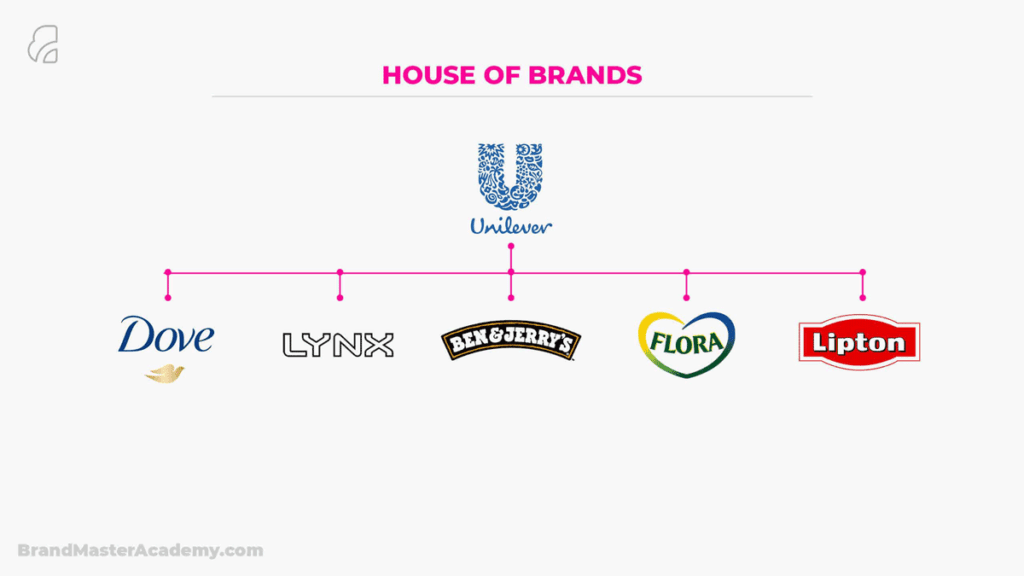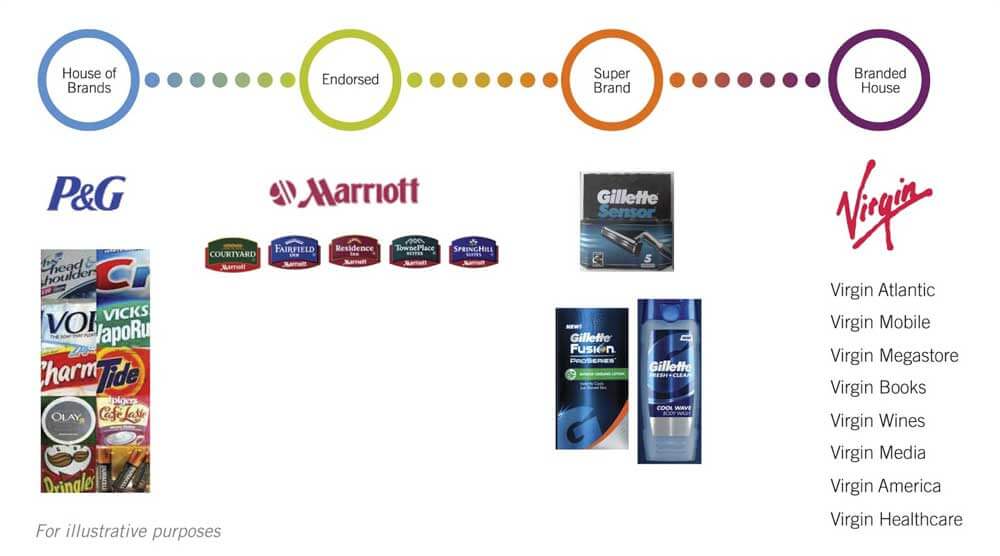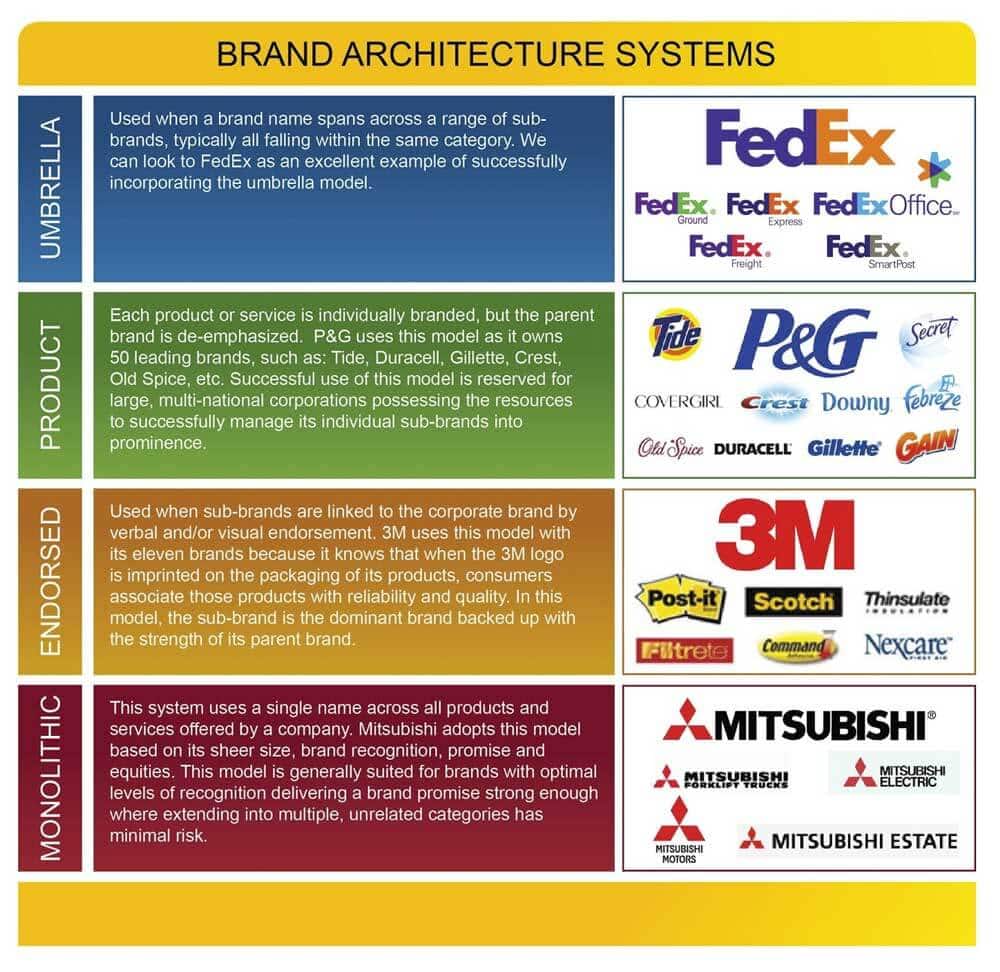Brand Architecture: Examples of Sub Brands & Models
Brand architecture is how a business manages and markets the product line or a brand. The design process is continuous and iterative, where ideas and concepts are validated and tested based on market trends. This means a brand must constantly evolve and develop new products and services to stay relevant and competitive.
In brand management, brand architecture generally is the arrangement of individual brands in an organisational structure.
It's how individual brands in a business's portfolio are connected to (and different from) each other.
A company may have one master brand, or it may have several. But whatever brand(s) a company has, it needs a logo, business name, and tagline to identify it.
A master brand might be part of a more extensive portfolio than the parent company. Or it might be part of a parent firm's portfolio.
In either case, the business must develop a strategy for building, maintaining, and enhancing its parent firm's brand portfolio. That strategy should take into account how customers will perceive those brands.
Brand architecture is a study of how brand architectures are applied in organisations.

There are four types of brand architecture: contextual, individual, strategic, and relational.
Contextual refers to how organisations arrange their brands concerning their actual product portfolio.
Individual brand architectures are designed to align a brand with a product.
Strategic brand architecture is designed to build brand equity over time.
Finally, relational brand architecture connects brands in a meaningful way.
So what is brand architecture, and what does it have to do with what is known as strategy formulation?
In principle, strategy formulation involves developing a list of goals and objectives for a particular project or initiative, a list of desired outcomes from that project, and a series of tactics or measures to achieve those objectives.
The idea is to lay out a logical plan for all of the possible actions that a company will need to realise its goal, in all likelihood, with the aid of new products or innovative marketing efforts.
A brand architect analyses the market and how various companies' marketing plans will interact with one another. The final step in this process is to develop and implement a plan.
Brand architecture makes sure that the strategies that companies apply are consistent.
It helps ensure that all of the strategies a marketing department applies align with one another and will not clash in the future should another product or marketing effort emerge.
However, many companies view a brand architecture process as an onerous task.
New Zealanders Jack Reardon and Declan Goughnage, who developed a brand consultancy in the early 1990s, believed that each division in a corporation must have its own strategy and marketing strategy.
With the help of their consultancy, they were able to identify and develop hybrid strategies, which were then able to operate efficiently when applied to each division.
Hybrid strategies emerged as the winning solution in many cases, especially because some of the original design principles of brand architecture conflicted.
In contrast, the newer hybrid models, such as the monolithic model, involved two logos for the umbrella brand and one for the rest of the properties.
The question then became: How could one company benefit from having its own brand architecture?
The answer is simple: if you want to succeed in the consumer market, you must create a unique image for customers to trust your name and product.
For example, a candle business owner can use labels on their candle packaging that say their brand initials, as recent studies have shown that it positively affects customer retention.
This is exactly what the parent brand architecture approach does.

If you create a product brand, you can use brand consultancy services to build a solid identity to increase sales.
Parent brands also provide training, marketing advice, and management resources to gain market share.
Some benefits companies gain include improved customer loyalty, higher productivity levels, and lower cost of products and services.
Brand architecture is essential to any business's success; however, developing and implementing brand architecture takes time, resources, and lots of trial and error.
However, the results are worth considering that you won't need to reinvent the wheel to create new products and services.
If you work with a trusted brand consultancy, you can develop a consistent brand architecture to help your company gain new customers and improve profitability.
You have to make sure that you work with the right people.
Table of Contents
Examples of Brand Architecture and Sub-Brands
Before the 2012 Olympics in London, if you were to ask an average person what Procter & Gamble was, you would probably not be able to get the correct answer.
Maybe a few people would recall something about hearing about a company by that name (others might have told you it was a legal agency of some kind).
However, if you were to ask those people what Pampers, Duracell or Tampax were, they would all know about them.
This is because, before the Olympics, Procter & Gamble had been more than successful in using the individual product brand strategy, where their master brand architecture didn't get much (if any) attention, while its products became household names.
In a way, this is a shame since their story had been a crazy one, involving supplying candles and soap to the Union army during the American Civil War and giving birth to soap operas, among other things. But that is a story for some other occasion.
What we are concerned with today is that Procter & Gamble has traditionally been one of the most successful (perhaps even the most successful) companies that almost exclusively used individual product branding, one of the three critical levels of branding.
Brand Architecture – the Metaphor
Before getting into brand architecture details, we should probably say something about the metaphor itself.
In other words, why brand architecture?
Brand architecture denotes a way in which companies, usually hefty multi-million (and billion) corporations, set up their master brand concerning their various products, teams of brands, endorsed brands, sub-brands and the innumerable relationships between all of these.
When all of this is put on paper, it becomes evident that this is an entity with its architecture, where you have the elements you would find in a building – foundations, supports, the roof and even the windows through which consumers can take a peek inside.
Different approaches to brand architecture will influence how a corporation approaches launching new brands, purchasing and integrating other businesses and creating a message to be conveyed to the consumers, partners, shareholders and even the competition.
3 Key Levels of Branding
To understand how different corporations approach their brand architecture, we need first to identify the three critical levels of branding.
1 – Corporate Branding
The first is corporate branding.
This type of branding is used by companies that face the world as a solid corporate brand that pervades everything they do.
The Virgin Group does this well; every endeavour comes with the Virgin prefix.
This kind of branding ensures that new brands from the same company are almost instantaneously accepted as sharing certain traits with the rest of the brands that belong to the company.
Corporate branding also saves a lot of money marketing-wise since the same messages can be used for a variety of the company's brands.
The main disadvantage of this kind of branding is that it can be difficult for brands to “make a name for themselves” as they are always in the shadow of the master brand architecture.
2 – Endorsed and sub-brands
Endorsed and sub-brands are brands where the corporate brand is included in creating this new brand but also stands on its own as a separate entity (as opposed to brands launched within a corporate branding structure).
Sony PlayStation is a great example of a sub-brand.
It is very obvious that it is a brand that is “under Sony's wing”, so to speak, but it is also a brand on its own, expected to make it on its own, regardless of what or how Sony is doing at the moment.
Endorsed brands rely less on the corporate brand, although its established nature provides some backing to the endorsed brand.
Nescafe by Nestle is a great example of an endorsed brand.
It is a perfect middle-ground where a new brand is provided much of the levity of its parent brand but is also unique enough to work on its own.
The main disadvantage of such brands is that they must live up to many consumers' expectations of the parent brand being the first.
Also, without actual value for the consumer, such a brand cannot succeed on its own, despite the parent brand's endorsement.
3 – Individual product brands
Individual product brands are what the P&G master brand did so well over the years.
These are brands that stand on their own without any visible connection with the parent brand architecture.
For example, most people have no idea that P&G stands behind the Pampers brand.
Brands that are promoted as individual product brands have to be strong enough to find their place on the market without falling back on the strength of their corporate master brand.
Such brands are also more versatile and easier to promote if sold to another corporate entity.

Branded house vs. house of brands
When talking about brand architecture, we cannot fail to mention David Aaker, a branding legend who has written more about brand architecture than anyone and has come up with a model for evaluating brand equity, the Aaker Model.
Among other brand architecture concepts, Aaker differentiates between two significant types of brand structures – the branded house and the house of brands.
A branded house architecture entails a strong master brand whose products do not have their own identities and are dependent on the strength of this master brand.
Amazon is an excellent example of this, as well as Virgin.
Coca-Cola‘s recent brand movements have also made it more of a branded house architecture brand, as its master brand has become more prominent over the last couple of years.
A house of brands architecture is what Procter & Gamble has been doing, allowing individual brands to speak for themselves and to compete without direct and obvious aid from the master brand.
The master brand is in the background, letting shareholders and investors know these individual brands have serious backing, so to speak.
The Importance of Brand Architecture
Brand architecture may seem like nothing more than a descriptive category where corporations “grow into” a particular architecture, mainly used to describe their inner workings. However, this is not the case.
A brand architecture allows large corporations to grow and build their brand portfolio in a controlled way.
In other words, they adopt a specific type of brand architecture to help their new (newly developed or acquired) brands perform better on the market.
For example, a corporation will deliberately feature a solid corporate master brand to reduce advertising costs.
When your corporate brand is super-strong, and your brands are mere outlets for the strength of the master brand, your entire line of products can be promoted using a single series of advertisements instead of having one for each.
This also helps reduce the costs of producing and distributing always-effective promotional products.
On the other hand, a corporation that often purchases established brands will avoid having a strong corporate brand and be more aggressive with individual brands.
Once again, we go back to the case of P&G, which has bought numerous brands over the years without brand consumers even being aware that the master brand has changed.

For example, the famous pet food company Iams was sold to P&G in 1999, and for the next few years, P&G owned the brand before selling it to Mars, Inc. (worldwide) and Spectrum Brands (Europe) in 2014.
If P&G had been a solid and aggressive master brand, some consumers might have decided to switch to other pet food brands during all these transitions.
It should also be pointed out that it would have been much more difficult for P&G to sell Iams (and other brands they have sold over the years) if they had been too associated with their master brand.
For instance, it would be pretty tricky for Virgin to sell any of its brands because, without Virgin, they are almost indiscernible from the competition.
When we talk marketing, companies like P&G have more freedom in building their brands.
They do not have a visual identity to preserve across their brand spectrum. They can be far more adventurous than, for example, Coca-Cola, whose brand identifiers are so ubiquitous and expected.
Of course, large corporations also approach brand architecture very carefully because doing it right enables them to offer a clear-cut way to present all of their products to consumers.
In addition, by establishing the right master brand architecture, companies can rest assured that they do not become their competition as various sub-brands start competing for the same market.
On top of all this, the master brand architecture will affect how the company in question relates to their investors and shareholders.
Closing Words
Brand architecture is a massive part of the corporate ecosystem. Learning more about it can unearth some interesting insights into how the biggest corporations handle the big picture.
The idea of brand architecture is to create a framework for the brands that you represent. In other words, it is a blueprint for your company.
It helps you define the critical attributes of your company.
The benefits of this are twofold:
- It helps you create a consistent look for your brand.
- It enables you to ensure that your products align with your master brand.
Brand architecture doesn't just apply to companies – it also applies to sub-brands, which are the components of a more prominent master brand.
In other words, if you're selling a product that comes under the umbrella of a master brand, you can create a sub-brand. This sub-brand will usually contain some subset of the features of the more prominent brand.
For example, if you're selling a software product, you could create a sub-brand called “Enterprise” that focuses on the enterprise version of your product.
Sign up for my free guide below to learn more about brand architecture!
FAQs
What does brand architecture mean?
Brand architecture is the creation of sub-brands within the parent brand. Sub-brands are used to increase the value of the parent brand. For example, Nike created their own shoe company, Jordan, to increase its value of Nike.
What is the difference between a sub-brand and a subsidiary?
A sub-brand is a separate company division that produces a product for the parent company. A subsidiary is a company that is under the control of another company. For example, Nike has a subsidiary, NIKE, Inc., responsible for producing Nike shoes.
What's the difference between a sub-brand and a brand extension?
A brand extension is a subsidiary brand that is not a sub-brand. For example, the Nike brand is an extension of sub-brands such as Air Jordan.
What is the difference between a sub-brand and a sub-model?
A sub-brand is a new brand created by the parent company. It's like a spin-off or a branch of the parent brand. The sub-model is a different brand, usually based on popular characters like Barbie or Hot Wheels.
Why do some brands have a sub-brand and some don't?
Some brands have a sub-brand because they want to be known as a particular brand. Other brands don't have a sub-brand because they don't want to be associated with any other brand.
What are some examples of brands and sub-brands?
Nike, Adidas, Reebok, and Under Armour are brands. Each has a sub-brand. The sub-brand is the umbrella under which Nike, Adidas, and Reebok are organised. For example, Nike has sub-brands: Nike Free, Nike Air, Nike Basketball, Nike Running, Nike SB, etc.
What are some examples of brands that have no brand architectures?
Apple has no brand architecture. Its brand identity, positioning, and communication focus on the Apple brand.
How can brand architecture help a business?
Brand architecture helps a business in several ways. For example, it allows the company to focus on what it does best while creating a new line of products.
What are the benefits of having a sub-brand?
A sub-brand allows a business to focus on its strengths, making it easier to market and sell the brand's product. It also allows the company to have a new effect different from the original brand.
